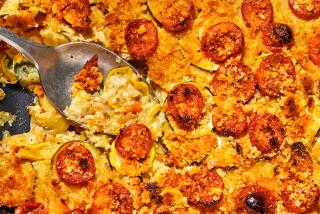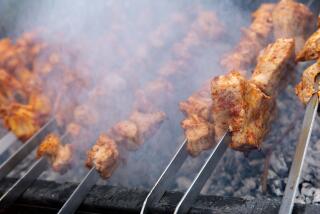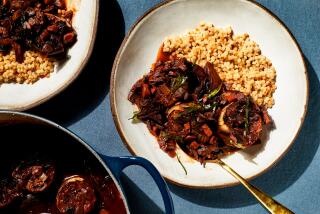Warmth of Provence
- Share via
MARVELOUSLY rich and winy, redolent of orange zest and cinnamon, bay leaf and garlic and fennel, with meat made tender by hours of slow simmering and, yes, those wonderful olives, a Provencal daube is a beautiful thing.
It began in the south of France. Daube (pronounced “dobe”) grew up in the Occitan, which cuts a wide swath across the entire southern part of the country. But it was in Provence that the dish attained its sunniest, most aromatic expression. That’s what makes la daube provencale so terribly appealing to the Southern California palate.
Daube is not just a dish; it’s also a method of cooking. It’s taken so seriously in Provence that a daube wouldn’t be a daube unless it were cooked in a daubiere, that quintessential Provencal cooking vessel. Made from the local red-gold clay, it’s almost spherical in shape, with a neck just large enough to insert your hand, a flat lid, and characteristic double handles to make lifting easy. (Fear not, though -- any heavy casserole or Dutch oven does well.)
The ingredients are layered inside the pot, with slow-cooking meats -- usually beef or lamb -- at the bottom, vegetables and aromatics on top. It’s not surprising to learn, then, that the word “daube” comes from adobar, which in the langue d’oc (language of the Occitan) means “to arrange” or “to accommodate.”
In Provence, those aromatics and vegetables would be onions, carrots, fennel, wild thyme, garlic, cloves, cinnamon, tomatoes -- in just about any combination. Wine -- red for beef, white for lamb or veal -- is essential, moistening the layers as a marinade.
And it’s a long marinade: The mix should be left in the refrigerator one to three days for flavors to blend.
Cooking is long and gentle, taking three to four hours so the heat from the oven (in the old days it was an open fire) gradually penetrates the heavy pot, warming the contents to a simmer so they marry over the hours to a glorious, aromatic, fork-tender finish. Partway through, olives and maybe artichokes are added.
*
Simple but special
THIS is a farmhouse dish, using inexpensive ingredients drawn from the surrounding countryside. But it’s not everyday food; a daube is special enough for a celebration. The meat needn’t be a tender cut; the long, slow cooking of the stew is specifically designed to break down tough tissues and cartilage, releasing their taste. The best cuts of beef to use are chuck, blade steak, shank, top or bottom round, and eye from the leg, the muscles that work hard. I always include a chunk or two of shank in my beef daube, or some ribs in a daube of lamb. You might call it my magic charm. I think it’s key in providing layers of flavor and that glossy richness that marks a fine sauce.
Many (though not all) Provencal daubes include bacon, cut into the classic chunky strips called lardons. In France it’s easy to find bacon in one piece, smoked or salted, complete with rind. If your butcher can provide it, go for the smoked version, slicing off the rind to line the base of the pot, then cutting the meat into lardons. Otherwise, thick-cut bacon can take the place of a single piece.
For an adventure here in California, you might like to substitute buffalo for beef; it’s the nearest match to meat from the magnificent Provencal black bulls, which is used in daubes in the Camargue, where they’re raised. There, at the delta of the Rhone River, they provide sport in the bullfighting arenas of the region.
The dark, musky Rhone red wines are a perfect match when marinating the meat.
Aromatic flavorings for a Provencal daube are key. Traditionally these may include pared orange zest (bitter orange is a particular treat), whole cloves, a cinnamon stick, peppercorns and a generous bunch of the classic bouquet garni trio of parsley, bay leaf and local wild thyme, dried to unusual intensity by the southern sun.
Here is a hint of history: The orange and spices come from the Arabs who colonized this part of France, and the herbal bouquet garni is resolutely French.
In Provence, the signature seasoning of the daube is olives. They may be green or black, large or small, mild or piquant. (Watch out for salty types that can overwhelm the mix.) Here’s where you can add a personal touch. The fat black olives from Nyons in northern Provence will be noticeably different from the tiny, nippy olives of Nice. Green olives are juicier, and for daube I prefer them brined. A French cook would always leave the olives whole, as the pits add flavor, but be sure to warn your guests if you leave them in!
Vegetables, the other supporting players in daube, include onions, carrots and always a bulb or two of fennel, the Provencal substitute for celery. In late winter and spring, baby artichokes, called poivrade, are another way to go; they’re delicious baked slowly in a lamb daube. (They haven’t arrived yet at the farmers markets, but you can get them at Trader Joe’s.)
Garlic is another variable: A few cloves will suffice if you’re using regular garlic, but come springtime, if you can find some fresh garlic at the market, be generous with it.
I remember being appalled when Provencal chef Antoine Bouterin once added a couple of dozen whole cloves of springtime garlic, but the results were sublime. Bouterin was equally lavish with his herbs, great fragrant bunches of thyme, oregano, rosemary, chervil, basil -- practically anything he could lay his hands on.
This largesse with seasonings was a first lesson for me in the Provencal kitchen.
*
A leisurely affair
INGREDIENTS for the daube assembled, the next step is cutting them to the right size. I like to slice beef into 1 1/2 -inch cubes, lamb a bit smaller, avoiding large, solid chunks that will cook more slowly than looser-textured pieces.
All the cuts I suggest (particularly beef shank and lamb ribs) contain streaks of cartilage and collagen that will gradually dissolve to be transparent and tender at the end of cooking, having contributed valuable gelatin to the sauce. When trimming, I’d suggest you leave all but the largest bits of cartilage, and also most of the fat (there won’t be much on these cuts). Vegetables should be chunky, as they will simmer a long time with the meat.
Tenderizing the meat for daube begins with marinating it with the vegetables in that indispensable ingredient: wine, and plenty of it. You need not break the bank; if a wine tastes good in the glass, it will be good in the daube as well.
Once you start using your hands to layer the ingredients, you’ll see why the traditional daubiere had a fist-sized mouth; in a regular open-faced casserole, layering is even easier. Slow-cooking meat comes first, followed by the vegetables and aromatics in their cheesecloth bag. Add the wine -- you can imagine how deliciously it will permeate those meats!
Find a place for the daubiere in the refrigerator and set your mind at rest. The beef or lamb and vegetables need at least a day, or up to three days, of marination for truly forceful flavor, so you can abandon them for a while. Daube is a leisurely affair.
To be readied for the oven, the daube is topped with chopped garlic, squishy chopped tomatoes and enough broth or water to almost cover everything. (Olives come later so they retain some taste.)
Lid on and you’re ready to bake -- gently. In Provence you can still see daubieres bedded among the hot embers of an open hearth, left to cook peacefully for four or five hours after taking an hour to come to a simmer. To get things going, in my own standard oven, I start the process at a higher heat, then lower the temperature.
Lamb takes two to three hours, and beef up to four hours to be tender enough to crush easily between your finger and thumb, the traditional test for a well-done stew.
I am always concerned about having too much liquid at the end of cooking. Some may need to be ladled out and boiled down. Then I taste it, adding freshly ground black pepper and a pinch or two of ground cinnamon if I’m so inclined.
You can make daube ahead and forget about it. Even after cooking is over, the stew is best after a day or two so the ingredients marry and mellow in the broth; it can be refrigerated in its pot up to three days, and it freezes well. Serve it when you and your guests are ready.
There’s a Provencal saying, “It’s as easy as daube.” Here’s the delicious proof.
**
Daube de boeuf Provencale (Provencal beef daube with red wine and black olives)
Total time: 5 hours plus 1 to 3 days marinating
Servings: 8
Note: Use a red wine such as a vigorous, tannic Cote du Rhone or a robust Shiraz. Serve with macaroni or polenta.
Bouquet garni
1 orange peel, pith (white part) scraped away
3 to 4 bay leaves
4 sprigs parsley
6 to 8 sprigs thyme
1 teaspoon black peppercorns
4 whole cloves
1 stick cinnamon
Tie the ingredients in a piece of cheesecloth. Set aside.
Daube
2 pounds chuck or round steak
1/2 pound piece smoked bacon
1 (2-inch) slice beef shank (about 1 1/2 pounds)
3 onions (about 1 pound), cut in eighths
3 large carrots, peeled, trimmed and cut diagonally in 1/2 -inch slices
2 medium bulbs fennel, tops trimmed, cut in eighths
1 bottle (750 ml) robust red wine
Bouquet garni
2 tablespoons olive oil
4 to 6 garlic cloves, coarsely chopped
2 pounds tomatoes, peeled, seeded and chopped (2 1/4 cups chopped) or 1 3/4 cups diced canned tomatoes, drained
Freshly ground pepper
1 cup (about 6 ounces) brine-cured black olives
1/4 cup chopped parsley
1. Trim the excess fat and cartilage from the beef steak and cut it in 1 1/2 -inch cubes. Cut the rind, if any, from the piece of bacon. Slice the bacon and cut the slices crosswise to make lardons.
2. Line a large (5 1/2 quart), heavy, ovenproof casserole with the bacon rind and put the beef shank on top. Add the beef cubes, lardons, onions, carrots and fennel, and pour the wine over.
3. Add the bouquet garni and push the bag down into the marinating ingredients. Spoon over the olive oil so they do not dry out. Cover and refrigerate at least 1 and up to 3 days.
4. When ready to cook, heat the oven to 400 degrees and put the oven rack in the lower third of the oven. Remove the daube from the refrigerator while the oven is heating. Sprinkle the daube with the garlic and chopped tomatoes, add 2 teaspoons salt and one-half teaspoon pepper, and pour in enough water to almost cover the vegetables. Cover and cook in the oven until the broth is almost simmering, about 45 minutes.
5. Stir the meat and vegetables. Add the olives. Reduce the heat to 300 degrees. Cook, stirring occasionally, until a cube of beef can be easily crushed between your finger and thumb, 2 1/2 to 3 hours more. The vegetables will be very tender.
6. Take the pot from the oven and lift out the slice of shank. It needs to be tender and falling off the bone, so will probably need more cooking: Put it in a medium saucepan and ladle in enough broth from the daube to cover the meat. Cover and simmer until the meat is almost falling apart, 30 to 45 minutes longer.
7. Remove the shank with the bone, and let cool until tepid. Return the broth to the casserole and discard the bouquet garni. Taste the broth. If the flavor is thin and needs reducing, ladle as much as possible into a saucepan and boil until the flavor is concentrated and the liquid is reduced by about half, to about 4 cups. Meanwhile, pull the meat from the bones of the shank and cut it into 1-inch pieces. Stir the meat gently into the casserole, with the marrow from the central bone. When the broth is reduced, stir it back into the daube, taste and adjust the seasoning.
8. If possible, prepare daube a day or two ahead and keep it, in its pot, in the refrigerator. Reheat it in a 350-degree oven, allowing at least an hour and probably more for heat to penetrate to the center. Just before serving, stir in the chopped parsley and check the seasoning again. Ladle the daube directly from the pot into shallow pasta bowls.
Each serving: 431 calories; 38 grams protein; 19 grams carbohydrates; 5 grams fiber; 16 grams fat; 4 grams saturated fat; 76 mg. cholesterol; 517 mg. sodium.
**
Daube d’agneau aux artichauts (Lamb daube with green olives, white wine and baby artichokes)
Daube de boeuf Provencale (Provencal beef daube with red wine and black olives)
Total time: 3 to 3 1/2 hours, plus 1 to 2 days marinating
Servings: 6 to 8
Note: The best cut of lamb for daube is shoulder; include some riblets, too, so the bones enrich the sauce.
Bouquet garni
1 lemon peel, pith (white part) scraped away
2 teaspoons coriander seed
2 teaspoons fennel seed
1 teaspoon black peppercorns
3 to 4 bay leaves
Tie the ingredients in a piece of cheesecloth and set aside.
Daube
1 1/2 pounds boneless lamb shoulder
1 1/2 pounds lamb riblets
4 onions (about 1 1/2 pounds), sliced
1 bottle Chardonnay
Bouquet garni
2 tablespoons olive oil
4 garlic cloves, chopped
2 large tomatoes, peeled, seeded and coarsely chopped or 1 1/4 cups diced canned tomatoes, drained
1 tablespoon dried thyme
Salt and freshly ground pepper
2 cups veal or beef broth, more if needed
1 cup (about 6 ounces) brine-cured green olives
Juice of 1 lemon
8 to 10 baby artichokes (about 2 pounds)
1 1/2 tablespoons softened butter
1 1/2 tablespoons flour
2 tablespoons chopped fresh flat leaf parsley
2 lemons, cut in wedges, for serving
1. Trim the meat, leaving bones and a little fat; cut the shoulder in 1 1/2 -inch pieces. Pack the lamb in a large (5 1/2 --quart), heavy, ovenproof casserole with the onions on top, and pour the wine over.
2. Pound the bouquet garni with a rolling pin to crush the spices. Push the bag down into the pieces of lamb and spoon over the olive oil. Cover and refrigerate at least a day and up to 2 days.
3. When ready to cook, heat the oven to 400 degrees. Remove the daube from the refrigerator while oven is heating up. Sprinkle the lamb with the garlic, tomatoes, and thyme. Stir 2 teaspoons salt and one-half teaspoon white pepper into the veal or beef broth and pour over the top. Cover and cook in the oven until the broth is almost simmering, about 45 minutes.
4. Reduce the heat to 300 degrees, stir in the olives and continue cooking the lamb, stirring occasionally, until it is nearly tender, about 45 minutes longer.
5. Meanwhile, add the lemon juice to a bowl of cold water. Trim each artichoke head, cutting crosswise about halfway down to remove tough tips. Snap off tough outer leaves and trim any remaining tough leaf tips. Trim the cut end of the stems, leaving 1 to 2 inches. Peel the stems with a vegetable peeler or small knife. Halve the artichokes lengthwise (quarter them if large) and scoop out any hairy central choke with a melon baller. Immerse the artichokes in the lemon water so they do not discolor.
6. When the lamb is nearly tender, drain the artichokes and stir them into the casserole, adding more broth if needed to half cover them. Simmer until the lamb meat is falling from the bones and the artichokes are very tender when you poke them with a fork, 30 to 40 minutes.
7. Remove the daube from the oven, let bubbles subside, and skim off excess fat. To make a beurre manie, combine the butter and flour in a small bowl and refrigerate. Remove and discard bouquet garni. Ladle as much of the broth as possible into a saucepan and bring to a gentle boil. Cook about 20 minutes, until the flavor is concentrated and the liquid reduced by half to about 3 cups. Add the butter-flour mixture a small pea-size piece at a time and whisk in. Bring the broth back to a boil for a few minutes. Pour it back into the daube, taste, and adjust the seasoning. Daube keeps well in the refrigerator up to 3 days, and can be frozen.
8. To serve, reheat the daube, if necessary, in the casserole in a 350-degree oven, allowing at least an hour and probably more for heat to penetrate to the center. Stir in the parsley and check the seasoning again. At the table, ladle the daube into shallow pasta bowls; pass lemon wedges on the side.
Each of 8 servings: 437 calories; 27 grams protein; 17 grams carbohydrates; 5 grams fiber; 23 grams fat; 8 grams saturated fat; 88 mg. cholesterol; 651 mg. sodium.


